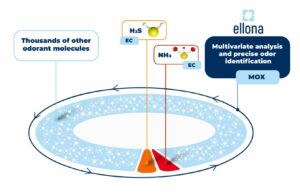Is the analysis of NH3 and H2S molecules enough to qualify and quantify odors (odours)?
- No, the analysis of H2S (hydrogen sulfide) and NH3 (ammonia) molecules is not sufficient to assess all odors (odours) present in an environment, especially in industrial sites or buildings where odor (odours) sources are diverse and complex. While these two molecules are commonly measured because they are responsible for certain noticeable odors (odours), such as rotten egg or ammonia smells, they represent only a small fraction of the chemical compounds responsible for bad odors (odours). In fact, many other volatile chemical compounds, often in low concentrations, can have significant olfactory impacts but are not captured by traditional sensors.
For example, mercaptans, volatile fatty acids, aldehydes, and ketones are other odorous substances frequently found in industrial, agricultural, or urban environments but are typically missed by systems relying solely on electrochemical sensors (EC) targeting H2S and NH3. These compounds, although sometimes present in low concentrations, can have a significant olfactory impact, and their identification is crucial for a complete and accurate assessment of odor (odour) nuisances.
- To obtain a more comprehensive evaluation of odors (odours), multivariate analysis becomes essential. This approach consists of measuring simultaneously a wide range of odor (odours) compounds, allowing a better understanding of the interaction between different molecules and more precisely identifying the sources of nuisances. The MOX (Metal Oxide Semiconductor) sensors used in Ellona devices are perfectly suited for this complex analysis. These sensors are capable of detecting dozens of compounds at the same time by measuring the sensor response to conductivity changes due to the adsorption of different odor (odours) molecules. This ensures a more exhaustive detection, encompassing not only H2S and NH3 molecules but also all other volatile substances responsible for bad odors (odours).

- Devices such as the WT1 Pro and WT1 Lite, designed for outdoor analysis, or the POD2, adapted for indoor environments, enable multidimensional odor (odour) monitoring. These sensors offer a much more complete and accurate view of odor (odour) nuisances, allowing specific zones with the highest odor (odour) concentrations to be identified. They also enable the tracking of odor (odour) pollution levels over time, which is particularly useful for detecting seasonal patterns or the effects of industrial activity.
- Thanks to the EllonaSoft platform, the analysis of data collected by MOX sensors becomes even more effective. In addition to providing real-time visualization of odor (odour) concentrations, EllonaSoft integrates advanced data analysis tools, allowing correlation with other factors such as weather conditions (wind, temperature, humidity), industrial activities, or changes in the local environment. This ability to analyze multiple variables simultaneously helps better understand odor (odour) dispersion dynamics and anticipate their impact on surrounding areas. For instance, if a critical odor threshold is detected, remediation actions can be automated.
Through this platform, you can also set up automatic alerts to notify facility managers when concentrations exceed critical thresholds. For example, this can trigger the automatic activation of ventilation or filtration systems to limit environmental impact. This not only reduces inconvenience for workers or local residents but also helps comply with environmental standards and avoid regulatory penalties.
In summary:
Ellona sensors, thanks to their ability to measure a broad range of odor (odour) compounds and their integration with the EllonaSoft platform, enable proactive odor (odour) nuisance management. The multivariate data analysis, combined with automated management, guarantees a more accurate, comprehensive, and efficient odor (odour) assessment on industrial sites or in buildings. This approach offers an optimal solution for improving air quality, protecting public health, and meeting environmental requirements.